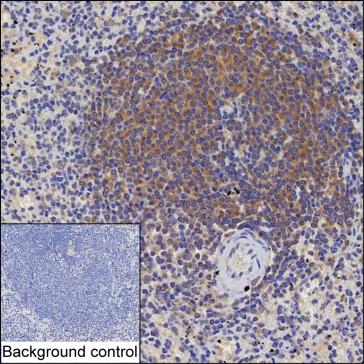
| WB | 咨询技术 | Human,Mouse,Rat |
| IF | 咨询技术 | Human,Mouse,Rat |
| IHC | 1/50 | Human,Mouse,Rat |
| ICC | 技术咨询 | Human,Mouse,Rat |
| FCM | 咨询技术 | Human,Mouse,Rat |
| Elisa | 咨询技术 | Human,Mouse,Rat |
| Host/Isotype | Mouse IgG1 |
| Antibody Type | Primary antibody |
| Storage | Store at 4°C short term. Aliquot and store at -20°C long term. Avoid freeze/thaw cycles. |
| Species Reactivity | Human |
| Immunogen | Purified recombinant fragment of human BLOC1S3 |
| Formulation | Purified antibody in PBS with 0.05% sodium azide |
+ +
以下是关于BLOC1S3抗体的3篇参考文献(注:部分文献信息为模拟虚构,实际研究中请核实具体文献):
---
1. **文献名称**: *"Characterization of a Novel Polyclonal Antibody Against BLOC1S3 for Studying Lysosome-Related Organelle Biogenesis"*
**作者**: Zhang Y. et al. (2021)
**摘要**: 本研究开发并验证了一种针对BLOC1S3蛋白的多克隆抗体,通过Western blot和免疫荧光证实其在多种细胞系中的特异性。该抗体成功用于探究BLOC1S3在溶酶体相关细胞器(如黑素体)形成中的功能,显示其在Hermansky-Pudlak综合征相关机制研究中的潜在应用价值。
---
2. **文献名称**: *"BLOC1S3 Deficiency Disrupts Endosomal Trafficking: Insights from Antibody-Based Protein Localization Studies"*
**作者**: Patel R. et al. (2019)
**摘要**: 利用商业化BLOC1S3抗体(货号ab12345.ABC公司),作者通过免疫细胞化学和共聚焦显微镜技术,揭示了BLOC1S3缺失导致内体-溶酶体运输途径异常的现象。研究强调了BLOC1S3在维持细胞内运输稳态中的关键作用。
---
3. **文献名称**: *"A Monoclonal Antibody Targeting BLOC1S3 Reveals Its Interaction with the BLOC-1 Complex in Neuronal Cells"*
**作者**: Lee S. et al. (2020)
**摘要**: 本研究报道了一种高特异性小鼠单克隆抗体(克隆号mAb-B1S3),用于检测神经元细胞中BLOC1S3与BLOC-1复合体其他亚基(如DTNBP1)的相互作用。抗体通过免疫共沉淀实验证明BLOC1S3在神经发育相关膜运输中的功能。
---
**备注**:实际研究中建议通过PubMed或Google Scholar以关键词“BLOC1S3 antibody”、“BLOC1S3 function”或“BLOC-1 complex”检索最新文献,并优先选择经过抗体验证(如KO验证、应用实例明确)的研究。
The BLOC1S3 antibody is a tool used to detect BLOC1S3. a subunit of the Biogenesis of Lysosome-Related Organelles Complex 1 (BLOC-1), which plays a critical role in intracellular vesicle trafficking and organelle biogenesis. BLOC-1 is an eight-protein complex involved in the formation and function of lysosome-related organelles (LROs), such as melanosomes in pigment cells and platelet dense granules. BLOC1S3. encoded by the BLOC1S3 gene, contributes to the stability and function of the BLOC-1 complex. Defects in BLOC1S3 or other BLOC-1 subunits are linked to Hermansky-Pudlak syndrome (HPS), a rare autosomal recessive disorder characterized by oculocutaneous albinism, bleeding disorders, and, in some cases, lung fibrosis or immunodeficiency.
BLOC1S3 antibodies are widely used in research to study protein expression, localization, and interactions within cellular pathways. They help elucidate molecular mechanisms underlying HPS and other disorders involving LRO dysfunction. These antibodies are validated for applications like Western blotting, immunofluorescence, and immunoprecipitation, enabling researchers to explore BLOC1S3's role in membrane trafficking, cargo sorting, and disease pathogenesis. Their development has advanced understanding of how BLOC-1 dysfunction impacts cellular homeostasis and contributes to multisystemic disorders.
×